

LP-ART_Le-Guide. Www.salons-biennales.com/Repertoire-des-salons-2014.pdf. Marketing for Self-Taught Artists. << Back to Articles for Artists Q: I've been painting for 20 years mainly for my own personal enjoyment, but people kept telling me how much they liked me art.
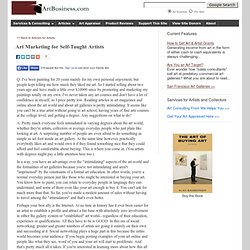
So I started selling about two years ago and have made a little over $10000 since by promoting and marketing my paintings totally on my own. I've never taken any art courses and don't have a lot of confidence in myself, so I price pretty low. Reading articles in art magazines and online about the art world and about art galleries is pretty intimidating. It seems like you can't be a true artist without going to art school, having years of fine arts courses at the college level, and getting a degree. A: Pretty much everyone feels intimidated in varying degrees about the art world, whether they're artists, collectors or average everyday people who just plain like looking at art. Perhaps your best ally is the Internet. Www.kerismith.com/wp-content/uploads/2010/06/survival1.pdf.
How to Photograph Your Art for Online Presentation, Email, Website. << Back to Articles for Artists The Internet has forever changed the way artists get the word out about their art, and that change is only just beginning.
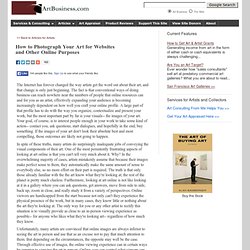
The fact is that conventional ways of doing business can reach nowhere near the numbers of people that online resources can and for you as an artist, effectively expanding your audience is becoming increasingly dependent on how well you craft your online profile. A large part of that profile has to do with the way you organize, contextualize and present your work, but the most important part by far is your visuals-- the images of your art. Your goal, of course, is to interest people enough in your work to take some kind of action-- contact you, ask questions, start dialogues, and hopefully in the end, buy something. If the images of your art don't look their absolute best and most compelling, those outcomes are likely not going to happen. Additional points to keep in mind: * Scale the art.
How to Write an Artist Statement - Explaining Your Art. Artist's Statement: Writing an Artist Statement. << Back to Articles for Artists Related article: How to Write Your Artist Statement Q: When anyone asks about my art, I refer them to my artist's statement, my resume, and some representative images of my current work.

Several people have told me that my statement is a little hard to understand and that maybe I should simplify it a bit. Le guide des ateliers d'artistes en France. Estúdio de Impressão Fine Art. Email Marketing Tips for Artists - How to Promote Your Art. "Here's my latest art.
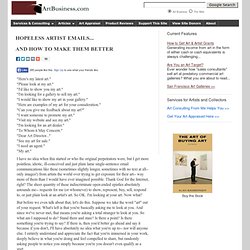
" "Please look at my art. " "I'd like to show you my art. " "I'm looking for a gallery to sell my art. " "I would like to show my art in your gallery. " "Here are examples of my art for your consideration. " I have no idea when this started or who the original perpetrators were, but I get more pointless, idiotic, ill-conceived and just plain lame single-sentence email communications like these (sometimes slightly longer, sometimes with no text at all-- only images!)
But before we even talk about that, let's do this. To begin with, I'd like to know why you emailed me. So that's the first thing. Next on the agenda, explain what qualifies you to contact whomever you're emailing. Then there's the core content of a typical hopeless email, usually consisting of one or two declarative sentences or phrases like "See my art" or "My art for sale" and maybe anywhere from one to four or five images (or sometimes many more). 1. Increase Art Sales; Sell More Art. << Back to Articles for Artists Any artist will tell you that one of the most difficult challenges they have to face is making a living.

The conventional way to achieve financial independence is through long term gallery representations, but many artists don't have that and of those who do, few have it on a consistent basis. Artists are innovative people, though, and have come up with a variety of other methods to bulk up their bottom lines. One of the easiest ways to make more money is to increase your name recognition. The best known artists sell plenty of art because they constantly make it visible and accessible to collectors. Sensory Ethnography Lab. Writing an artist statement? First ask yourself these four questions. "Combining radical notions of performativity and the body as liminal space, my practice interrogates the theoretical limitations of altermodernism.
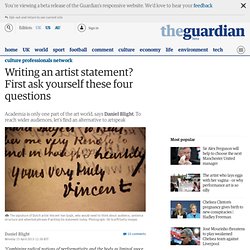
My work, which traverses disparate realms of object-making such as painting and performance, investigates the space between metabolism and metaphysics and the aporia inherent to such a discourse. " Are you impressed yet? These forms of writing are scattered across the contemporary art world. You can find preposterously complex, jargon-laden artist statements on the websites of galleries and pop-up project spaces all over the English-speaking world. If you don't believe me, join the e-flux mailing list. This is a dialect of the privileged; the elite university educated. The funny thing is, the chat you actually hear at a gallery opening rarely uses this language. What is the alternative to artspeak? Where does this artspeak come from? Who are you really writing for? Consider your audience. You must consider the remit of these different places. Profil culture.
How to work with galleries and collectors as an emerging artist. Showing work in a gallery exhibition.
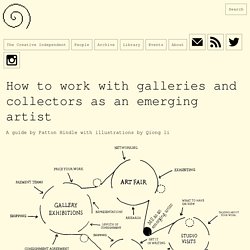
A gallery has offered to include your work in a group or solo exhibition—what can you expect? What do you need to make sure everything is in order before the exhibition opens? Use a consignment agreement First things first, never send a gallery your work without receiving a consignment agreement. This document protects both you and them. A standard agreement sets out the terms for the sale of the work, your payment (should the work sell), how the work will be shipped, how the work will be photographed/documented, and the length of time that the gallery will have exclusive access to sell the work.